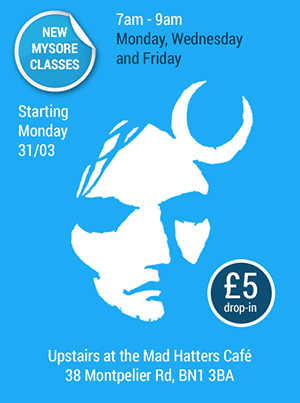 I’m very excited to announce that I’ll be teaching early morning Mysore classes on Monday, Wednesday and Fridays from 7am – 9am upstairs at the Mad Hatter’s Cafe starting on Monday 31st of March. UPDATE: Our Mysore group now practices at Revitalise Brighton (123A Western Road, BN3 1DB) from 06:30 – 08:30 Mon, Wed and Fri.
I’m very excited to announce that I’ll be teaching early morning Mysore classes on Monday, Wednesday and Fridays from 7am – 9am upstairs at the Mad Hatter’s Cafe starting on Monday 31st of March. UPDATE: Our Mysore group now practices at Revitalise Brighton (123A Western Road, BN3 1DB) from 06:30 – 08:30 Mon, Wed and Fri.
If you read my previous post Big Changes you’ll know that 2014 is bringing big changes to both my personal and work life. I’ve been teaching evening classes for a few years now but my great love is morning Mysore style practice, the very same that I’ve committed to since 2006.
An introduction to Mysore style practice
If you’re new to Ashtanga yoga then it’s worth explaining what Mysore style practice is. It originates from Mysore India, where it is still practiced today in the traditional way. A Mysore class is unique because it’s not a led class with the teacher standing at the front of the room conducting the class. Instead each practitioner works at their own pace through a set series of postures.
In India it’s tradition that spiritual practice is undertaken at day break before one’s other duties. So it’s common for people to practice as early as 4:30am. Most Mysore style classes around the world start from around 6am onwards.
The Ashtanga series
There are 4 distinct sequences/series in Ashtanga Yoga. The primary series which is learned first can take anything from 9 months to 5 years to complete. Each series gets progressively more advanced and challenging. The keys to progression is patience, humility and daily practice.
The teacher
I will be on hand to assist students offering hands-on adjustments and verbal instruction explaining the next posture when appropriate. Adjustments enable the student to go more deeply into each posture and also assist with alignment. Complete beginners start right at the beginning with a series of postures known as the sun salutation or Surya Namaskara. Each practitioner slowly memorises the sequence which they practice each day. But don’t worry it all builds up gradually.
Breathing, dristi and vinyasa
Other unique aspects of Ashtanga yoga is the focus on developing a deep, even and steady breath as well as specific gazing points (called dristis) to focus on in each posture. In fact each posture has a set number of prescribed breaths – but that’s a bit too much detail at this point.
The postures are linked together by a series of movements called a vinyasa. This give Ashtanga Yoga it’s flowing quality and increases the heat and intensity of the practice.
What to expect
- The room will be quiet and warm but not hot.
- You should hear the sounds of people beathing deeply.
- People will be moving and breathing as they go through their practice at their own pace.
- I will be assisting practitioners with their practice either verbally or with hands on adjustments.
- At 7:30am I’ll stop the class and together we’ll all do the opening chant. Don’t worry if you don’t know this. I’ll be leading this sanskrit chant or mantra in call and response. If you’d like to know what the opening mantra means check out this blog post.
- After the opening mantra everyone will continue where they left off.
Beginners
Please let me know you intend on coming the night before by text. If you’re a complete beginner it would be ideal for us to have a chat first. My number is below, so please feel free to ring me.
Your first time
- When you arrive find a spot near the back of the room and unroll your mat and stand at the front of it.
- I’ll come over and talk you through your first sequence of movements.
- Once you’ve finished all your postures you can lie down and close your eyes and take rest.
- Allow your body and your breathing to completely relax for 5 – 10 minutes as your schedule allows.
- Don’t forget to pay on your way out.
As you attend regularly (3 times/week) I’ll introduce you to new postures gradually as you build up your strength and flexibility safely.
Etiquette
Yoga is a practice of drawing your attention inwards focusing on the sound of your own breath.
It’s considered inpolite to stare at other practitioners while they are practicing.
Eye contact
Generally other practitioners will not make eye contact with you. Don’t be put off by this, they’re not being unfriendly, It’s just that their focus is on their practice.
Talking
Discussion or chatting is discouraged. Keeping the space quieter allows us to go deeper into our own practice, encouraging reflection and a sacred space.
Got any questions?
Just give me a ring on 07971 558 067 or drop me an email at guy@ashtangabrighton.com

No comments yet.